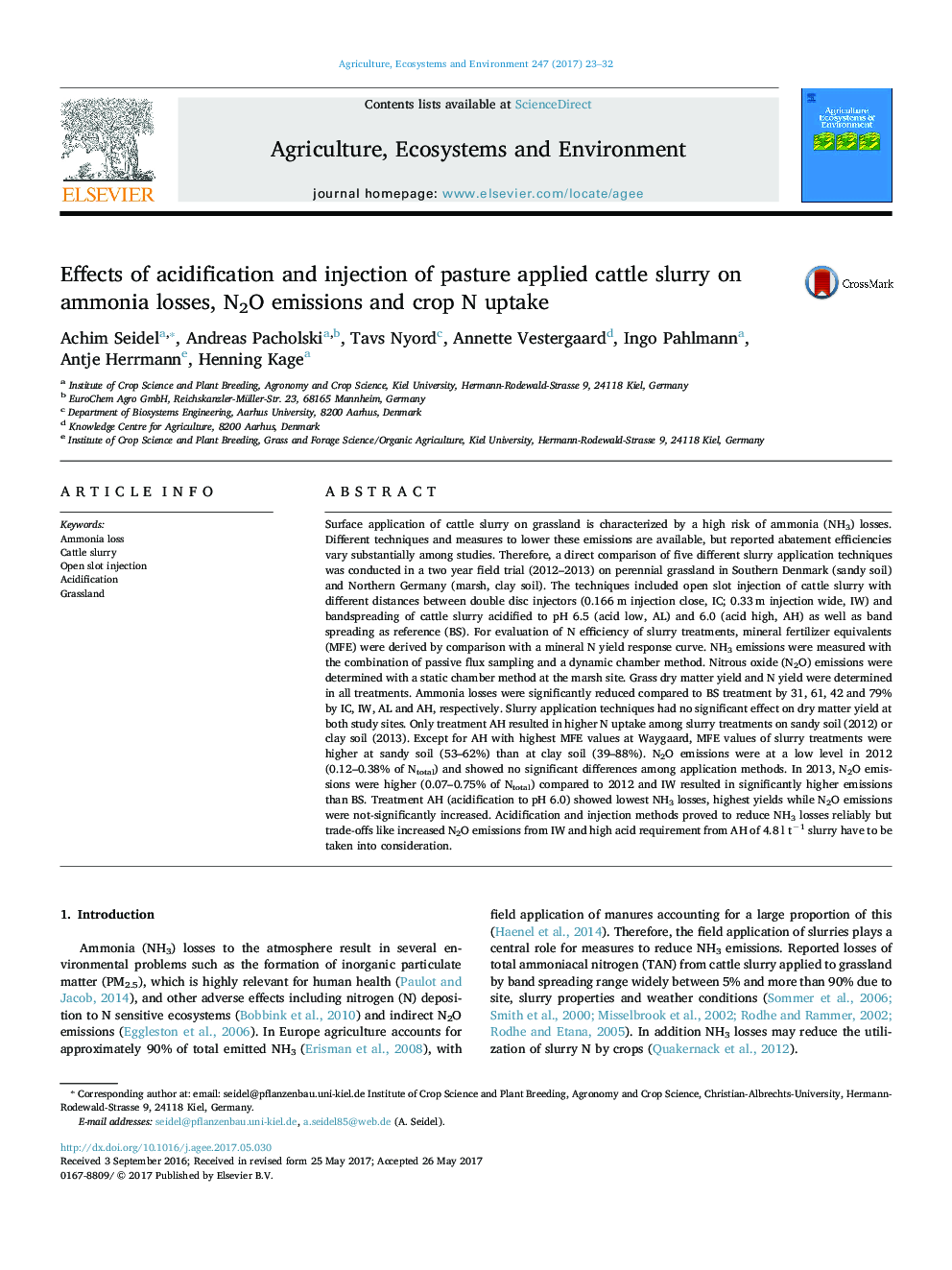| کد مقاله | کد نشریه | سال انتشار | مقاله انگلیسی | نسخه تمام متن |
|---|---|---|---|---|
| 5537974 | 1552005 | 2017 | 10 صفحه PDF | دانلود رایگان |
عنوان انگلیسی مقاله ISI
Effects of acidification and injection of pasture applied cattle slurry on ammonia losses, N2O emissions and crop N uptake
دانلود مقاله + سفارش ترجمه
دانلود مقاله ISI انگلیسی
رایگان برای ایرانیان
کلمات کلیدی
موضوعات مرتبط
علوم زیستی و بیوفناوری
علوم کشاورزی و بیولوژیک
علوم زراعت و اصلاح نباتات
پیش نمایش صفحه اول مقاله

چکیده انگلیسی
Surface application of cattle slurry on grassland is characterized by a high risk of ammonia (NH3) losses. Different techniques and measures to lower these emissions are available, but reported abatement efficiencies vary substantially among studies. Therefore, a direct comparison of five different slurry application techniques was conducted in a two year field trial (2012-2013) on perennial grassland in Southern Denmark (sandy soil) and Northern Germany (marsh, clay soil). The techniques included open slot injection of cattle slurry with different distances between double disc injectors (0.166 m injection close, IC; 0.33 m injection wide, IW) and bandspreading of cattle slurry acidified to pH 6.5 (acid low, AL) and 6.0 (acid high, AH) as well as band spreading as reference (BS). For evaluation of N efficiency of slurry treatments, mineral fertilizer equivalents (MFE) were derived by comparison with a mineral N yield response curve. NH3 emissions were measured with the combination of passive flux sampling and a dynamic chamber method. Nitrous oxide (N2O) emissions were determined with a static chamber method at the marsh site. Grass dry matter yield and N yield were determined in all treatments. Ammonia losses were significantly reduced compared to BS treatment by 31, 61, 42 and 79% by IC, IW, AL and AH, respectively. Slurry application techniques had no significant effect on dry matter yield at both study sites. Only treatment AH resulted in higher N uptake among slurry treatments on sandy soil (2012) or clay soil (2013). Except for AH with highest MFE values at Waygaard, MFE values of slurry treatments were higher at sandy soil (53-62%) than at clay soil (39-88%). N2O emissions were at a low level in 2012 (0.12-0.38% of Ntotal) and showed no significant differences among application methods. In 2013, N2O emissions were higher (0.07-0.75% of Ntotal) compared to 2012 and IW resulted in significantly higher emissions than BS. Treatment AH (acidification to pH 6.0) showed lowest NH3 losses, highest yields while N2O emissions were not-significantly increased. Acidification and injection methods proved to reduce NH3 losses reliably but trade-offs like increased N2O emissions from IW and high acid requirement from AH of 4.8 l tâ1 slurry have to be taken into consideration.
ناشر
Database: Elsevier - ScienceDirect (ساینس دایرکت)
Journal: Agriculture, Ecosystems & Environment - Volume 247, 1 September 2017, Pages 23-32
Journal: Agriculture, Ecosystems & Environment - Volume 247, 1 September 2017, Pages 23-32
نویسندگان
Achim Seidel, Andreas Pacholski, Tavs Nyord, Annette Vestergaard, Ingo Pahlmann, Antje Herrmann, Henning Kage,